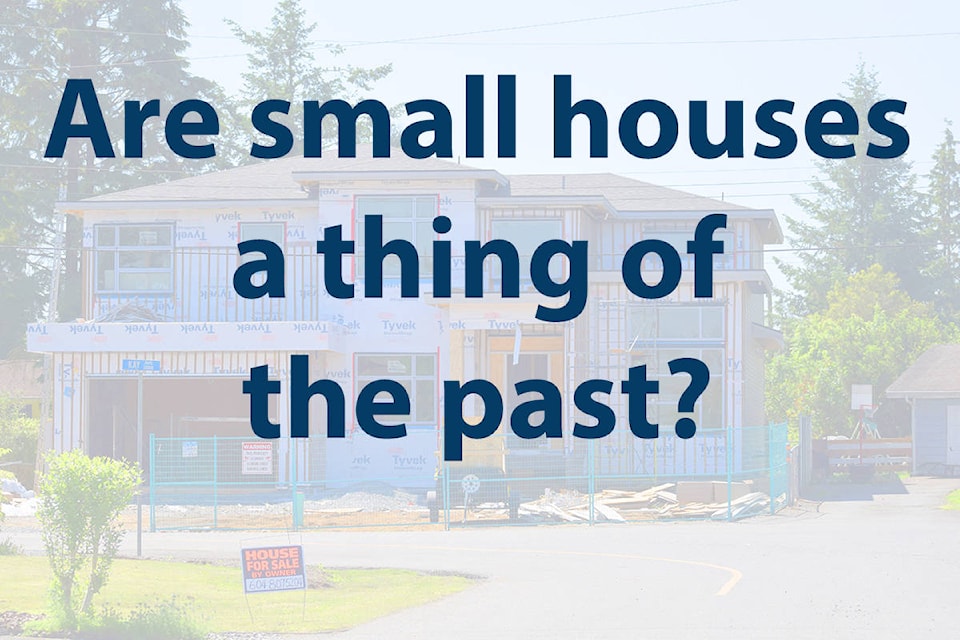Everybody seems to want smaller houses – except for those people plunking down money to build new single-family homes these days.
As the city tweaks its rules that govern what kind of new houses get built in central, established neighbourhoods, Mayor Henry Braun said at a recent council meeting that Abbotsford needs to find a way to get developers to build smaller, more-affordable houses.
But it’s unclear how, exactly, the city can accomplish that, given sky-high land prices, a marketplace that demands big homes and buyers’ turn towards townhouses.
In 2010 and 2011, more than one-quarter of all new houses built in Abbotsford were less than 3,000 square feet. But small houses are no longer such a common sight. Last year, just 13 per cent of houses were less than 3,000 square feet; and so far, in 2019, just seven of 77 building permits for new houses this year were for such smaller homes.
RELATED: New rules could curb house sizes in certain areas of Abbotsford
Story continues below
Arnold Meinen, who has built homes in Abbotsford for decades, said buyers today want top-of-the-line materials and prefer big houses to decent-sized yards.
Meinen likes the concept of small, reasonably sized homes, and recently had a hand in building a handful of ultra-rare sub-2,000-square-foot homes on Old Clayburn Road.
But he said most customers don’t want small.
“They don’t want to come home from work and work on their yards,” he said. Rather, they demand things like theatre rooms that you can’t get in a small house. And even those on a budget “still want all the bells and whistles.”
Meinen says dropping development cost charges could help bring down the cost to get shovels in the ground on smaller homes.
He said he would like to get back to the days when moderately sized “B.C. Box” style homes with basic finishings could be built and sold for an affordable price.
“I would love to go out and say ‘I’m going back to basics,’ ” he said.
It’s not true that smaller homes aren’t getting built. They just tend to be townhomes, rather than single family houses with larger yards. Between 1999 and 2008, six single-family houses were built for every townhouse. The previous decade, though, saw more than 1,000 townhomes built across Abbotsford. Between 2009 and 2018, for every two single-family houses built in Abbotsford, one townhouse unit went up (along with increasing numbers of apartments).
And over the last 12 months, more townhomes have been completed than single-family houses – a statistic that would have been unthinkable in the early 2000s, when over a stretch of 27 months, just three townhouses were built.
Story continues below
Some of the recent decrease in small-house construction could be tied to a decision last year to halt development in central areas designated for “infill,” whereby a single home on a large lot is torn down and replaced by two or more newer homes. Such infill is meant to increase the density of older neighbourhoods, but feedback from both residents and the development industry led to the halt.
Planners are now tweaking the rules in order to try to appease residents while making it economically feasible to build the types of houses the city would like to see. As part of that work, the city went to residents to find what kind of homes they would like to see. Subdivisions and increasing density weren’t the main problem, the city heard at the time. Instead, residents were most upset when a small existing house was simply replaced by a new mansion. The rules in place allowed new houses to be built too tall and too wide, residents said. Most, though, had no problems with a single house being replaced by two narrow homes or a duplex unit.
RELATED: Abbotsford halts new infill subdivisions as it awaits new rules
Braun said earlier this month that the city has the tools to incentivize the building of more small houses. He pointed out that its rules now allow for the building of small, separated “granny suites” that can provide bachelor unit-sized homes behind existing houses. Finding a way to encourage small houses is the next step, he said.
But Brandon Ogumndson, an economist with the BC Real Estate Association, said small houses suggested that’s hard to do, given the economics of home-building.
Property prices reflect the “highest and best use” of a piece of land, and developers who want to make money will usually build the biggest houses they can to maximize their profit.
“A developer is always going to go for what [provides] the highest return,” he said. Cities could implement rules that limit house sizes, but that has the potential of deterring the building of new homes to begin with.
“I don’t know why you’d do that instead of just zoning for multi-family,” he said. “Ultimately, what would make more sense is townhouses or row houses … A townhouse gives you a lot of what a single family house gives you anyways.”
@ty_olsen
tolsen@abbynews.com
Like us on Facebook and follow us on Twitter.
